A world of sand
On the way further north the crops change and sugar cane and pineapple dominate the scenery; in the paddocks heat and drought resistant Brahman cattle replace Angus or Hereford.
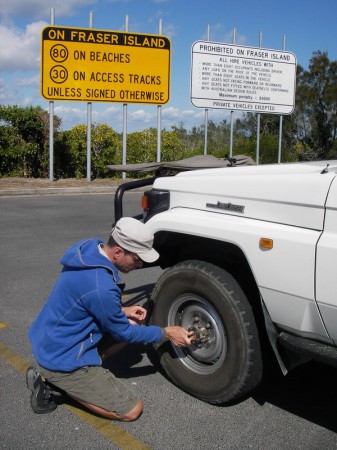 When we arrive at River Heads in Hervey Bay, the car park at the barge ramp is empty and there is plenty of time to get ready for the island, for Fraser Island that is. We have already stocked up our supplies and should not have to restock for at least 2 weeks. The gauge shows 46 Psi when we check the tyre pressure and we deflate to 20; this should get us through the sand without problems.
When we arrive at River Heads in Hervey Bay, the car park at the barge ramp is empty and there is plenty of time to get ready for the island, for Fraser Island that is. We have already stocked up our supplies and should not have to restock for at least 2 weeks. The gauge shows 46 Psi when we check the tyre pressure and we deflate to 20; this should get us through the sand without problems.
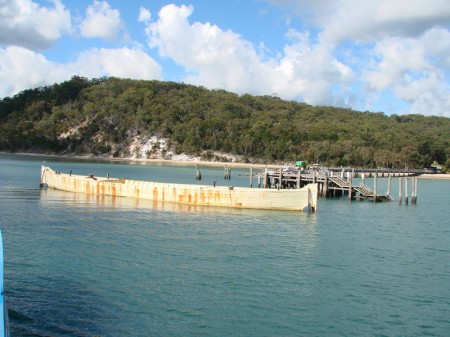 The ride on the barge across Great Sandy Strait takes just 40 minutes. Dolphins, turtles and a white-breasted sea eagle join us for a while and then the landing at Kingfisher Bay appears in the distance. What a great feeling to set foot to the island again after 10 years. And it seems to be every bit as beautiful and magic as we remembered it. After a quick look around at Kingfisher we get serious and head inland. The massive fence just behind the resort hasn’t been there last time; the electric cattle grid looks like out of “Jurassic Park” and we wonder what dangerous beast may roam the peaceful island.
The ride on the barge across Great Sandy Strait takes just 40 minutes. Dolphins, turtles and a white-breasted sea eagle join us for a while and then the landing at Kingfisher Bay appears in the distance. What a great feeling to set foot to the island again after 10 years. And it seems to be every bit as beautiful and magic as we remembered it. After a quick look around at Kingfisher we get serious and head inland. The massive fence just behind the resort hasn’t been there last time; the electric cattle grid looks like out of “Jurassic Park” and we wonder what dangerous beast may roam the peaceful island.
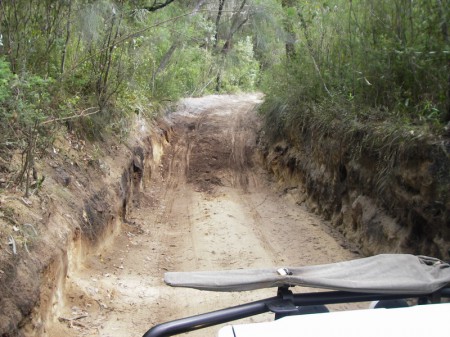
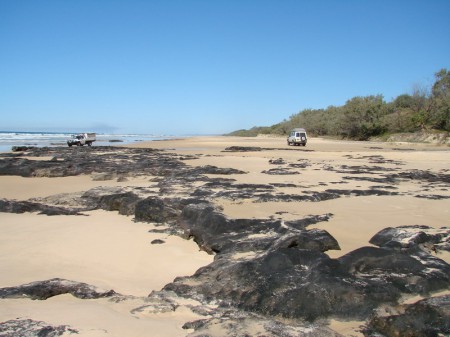 The vehicle tracks on Fraser consist entirely of the same material than the island itself, sand, sand and more sand. Around Kingfisher and Central Station the tracks are pretty rough in places and the sand very soft and deep. Getting around without a four wheel drive with a decent ground clearance is impossible. We feel a bit uneasy at first, the single lane inland sand tracks with a 30km speed limit are not always easy going and oncoming cars can only be passed at certain points. Reversing is difficult at times and at the designated passing points the sand is quite often even deeper.
The vehicle tracks on Fraser consist entirely of the same material than the island itself, sand, sand and more sand. Around Kingfisher and Central Station the tracks are pretty rough in places and the sand very soft and deep. Getting around without a four wheel drive with a decent ground clearance is impossible. We feel a bit uneasy at first, the single lane inland sand tracks with a 30km speed limit are not always easy going and oncoming cars can only be passed at certain points. Reversing is difficult at times and at the designated passing points the sand is quite often even deeper.
Our Landcruiser behaves well though and thanks to the wide, deflated tyres we make it to the other side without getting stuck. After slightly more than an hour the forest opens up and we drive onto the eastern beach. We enjoy the ride north along the surf, at the same time feeling guilty that our driving is spoiling the peace and quiet of this beautiful stretch of coastline. All the vehicles share the beach with small planes, which use the firm sand as a convenient air strip.
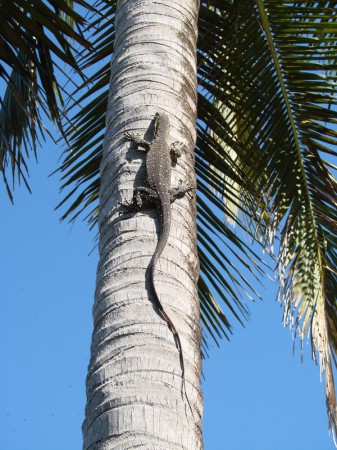 At Happy Valley we leave the beach and pull up in front of our little cottage minutes later. What a beautiful little paradise and our home for the next 10 days! Native plants and coconut palms create a tropical atmosphere and the resident goannas seem to have gathered to welcome us. Bree, our host, comes around for a chat and her passion and love for the island is obvious. Her knowledge is going to be a great source of information and making our stay even more enjoyable. Bree also tells us about the fences and the electric grids that have been put up in the last 8 years.
At Happy Valley we leave the beach and pull up in front of our little cottage minutes later. What a beautiful little paradise and our home for the next 10 days! Native plants and coconut palms create a tropical atmosphere and the resident goannas seem to have gathered to welcome us. Bree, our host, comes around for a chat and her passion and love for the island is obvious. Her knowledge is going to be a great source of information and making our stay even more enjoyable. Bree also tells us about the fences and the electric grids that have been put up in the last 8 years.
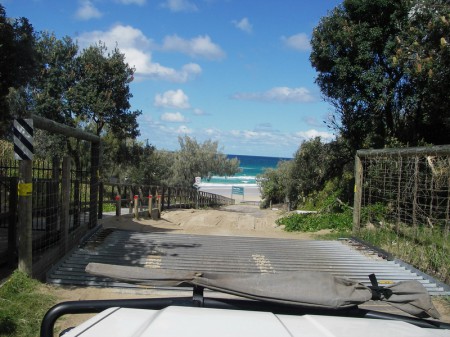 Fraser Island is home to one of the purest populations of Dingoes remaining in Australia. Stupid and irresponsible behavior of visitors caused several attacks and despite the fact that most of Fraser is declared a National Park and belongs to a World Heritage area, supposedly to protect its natural values, problem Dingoes have been destroyed (official term!!) and fences have been erected.
Fraser Island is home to one of the purest populations of Dingoes remaining in Australia. Stupid and irresponsible behavior of visitors caused several attacks and despite the fact that most of Fraser is declared a National Park and belongs to a World Heritage area, supposedly to protect its natural values, problem Dingoes have been destroyed (official term!!) and fences have been erected.
 The next ten days see us exploring the island and reading the books about the area given to us by Bree. It is great to gain an insight into the history of Fraser Island, its human inhabitants and its flora and fauna and visit some of the places described. There is a unique range of habitats from rainforest to dry heathlands, from wetlands teaming with life to seemingly lifeless barren sand dunes, from miles and miles of golden beaches on the island’s eastern side to its western mangrove fringes. Despite the fact that the island consist mainly of sand, it features many freshwater lakes. The usually permeable sand is made impermeable in places by layers of decomposed organic matter, which prevents the water from draining. Other lakes are simply a depression in the sand reaching into the underlying water table.
The next ten days see us exploring the island and reading the books about the area given to us by Bree. It is great to gain an insight into the history of Fraser Island, its human inhabitants and its flora and fauna and visit some of the places described. There is a unique range of habitats from rainforest to dry heathlands, from wetlands teaming with life to seemingly lifeless barren sand dunes, from miles and miles of golden beaches on the island’s eastern side to its western mangrove fringes. Despite the fact that the island consist mainly of sand, it features many freshwater lakes. The usually permeable sand is made impermeable in places by layers of decomposed organic matter, which prevents the water from draining. Other lakes are simply a depression in the sand reaching into the underlying water table.
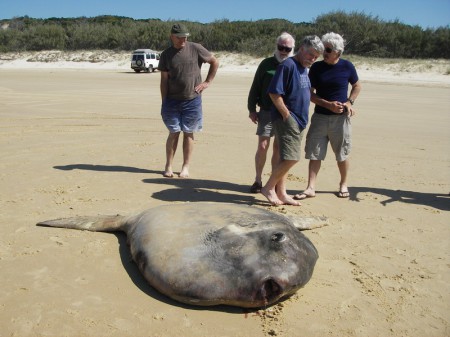 On our walks and drives we come across an abundance of wildlife. In the pristine freshwater lakes and streams we spot turtles, rainbow fish, eels and even jungle perch. At dusk Dingoes appear regularly and patrol the beaches in search of a morsel or two. We love our beach walks and always collect bits and pieces the sea has left behind. One day we come across some beautifully marked jelly fish and even a more than 2 meters long sunfish, thrown onto the sand like all the other flotsam by relentless waves. The weird and wonderful fish impresses us even in its death and we try to imagine how beautiful it looked when gliding effortlessly through the water.
On our walks and drives we come across an abundance of wildlife. In the pristine freshwater lakes and streams we spot turtles, rainbow fish, eels and even jungle perch. At dusk Dingoes appear regularly and patrol the beaches in search of a morsel or two. We love our beach walks and always collect bits and pieces the sea has left behind. One day we come across some beautifully marked jelly fish and even a more than 2 meters long sunfish, thrown onto the sand like all the other flotsam by relentless waves. The weird and wonderful fish impresses us even in its death and we try to imagine how beautiful it looked when gliding effortlessly through the water.
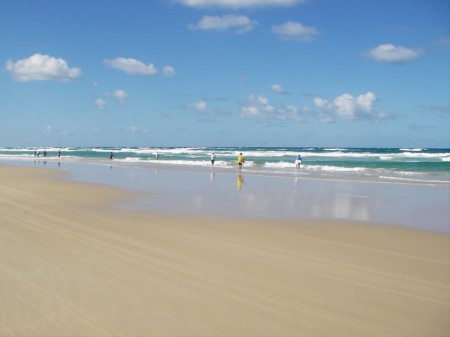 The annual Tailor run on the island’s east coast attracts thousands of anglers, keen to catch their share of the tasty fish. At high tide, countless groups of fishos in yellow oilskins are dotting the beach, casting their offerings into the surf. Bait and chrome lures work a treat at times and the bag limit may be reached quickly.
The annual Tailor run on the island’s east coast attracts thousands of anglers, keen to catch their share of the tasty fish. At high tide, countless groups of fishos in yellow oilskins are dotting the beach, casting their offerings into the surf. Bait and chrome lures work a treat at times and the bag limit may be reached quickly.
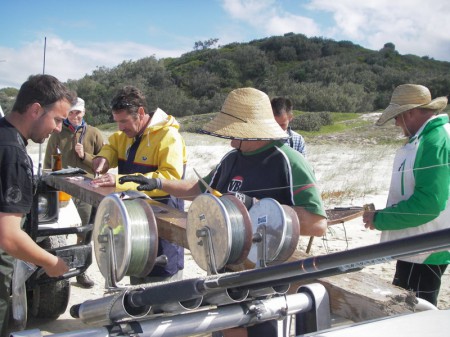 A very friendly bunch of fishermen from the Lockyer Valley near Brisbane are staying next door and we enjoy our little chats at night. One late afternoon the sky gets covered in thick black clouds within minutes and moments later a reasonable subtropical thunderstorm breaks loose. The coconut palms
A very friendly bunch of fishermen from the Lockyer Valley near Brisbane are staying next door and we enjoy our little chats at night. One late afternoon the sky gets covered in thick black clouds within minutes and moments later a reasonable subtropical thunderstorm breaks loose. The coconut palms
bend like jelly sticks and we fear that they are going to break. Suddenly we realize that our absent neighbors have placed all their gear and cloth outside to have everything dried by the sun. Quickly we rescue their stuff and place it on the large covered veranda. Later we get generously rewarded for our little effort and get invited for a delicious feast of fresh fish for dinner. The storm doesn’t last very long and after about an hour the rain eases and the wind drops without having caused any serious damage.
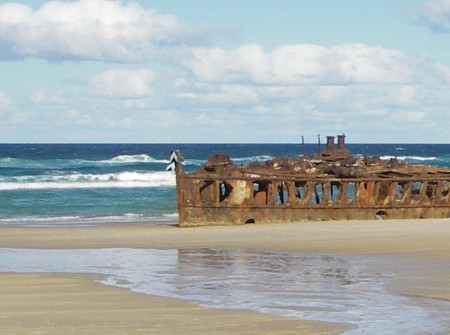
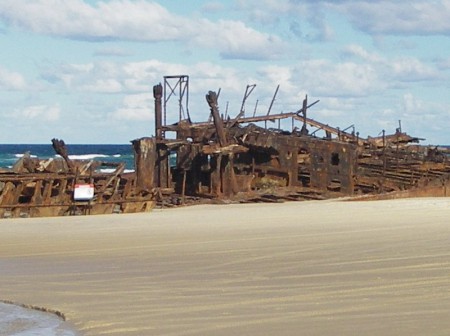
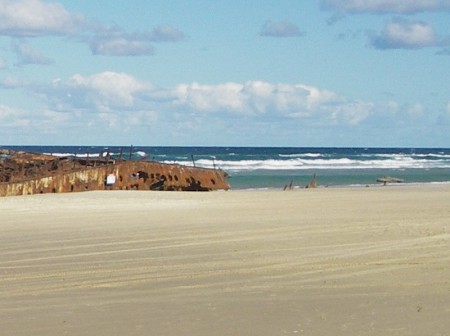 Some of the more touristy attractions like the Maheno wreck and Eli Creek are bustling with people and we enjoy chatting with fellow travelers. Eli Creek can be a very peaceful little place, in the tourist season though it gets hammered by commercial operators and the crystal clear creek gets flooded with screaming and splashing visitors most of the day. The resident jungle perch don’t seem to mind and only head for cover when too many human beings seek relief from the heat in the cool freshwater.
Some of the more touristy attractions like the Maheno wreck and Eli Creek are bustling with people and we enjoy chatting with fellow travelers. Eli Creek can be a very peaceful little place, in the tourist season though it gets hammered by commercial operators and the crystal clear creek gets flooded with screaming and splashing visitors most of the day. The resident jungle perch don’t seem to mind and only head for cover when too many human beings seek relief from the heat in the cool freshwater.
Time goes by far too quick once more and we have to say good bye. Hope to be back one day! All the very best to you, Bree. May all your good work and efforts bear fruits!
Fraser Island facts
Area 184’000 hectares
Length 123km, average width 14km
Fraser Island and neighboring Cooloola represent the world’s largest vegetated dune
systems and are part of the Great Sandy Region. Fraser Island became World Heritage listed in 1992 and is home to many rare and endangered plants and animals.
The area is of great cultural significance with at least 40’000 years of Aboriginal occupation. The island was taken from the last native occupants about 100 years ago, when they were killed or deported to make room for progress and profit.
Fraser Island and Cooloola attract a massive number of visitors, over 500’000 a year. After
logging and sand mining have been stopped, there are still a lot of issues to be addressed and solved to secure the unique natural value of the area for the future. Many of the island’s unique ecosystems are fragile and cannot cope with thousands and thousands of people who regard Fraser as a giant adventure playground.
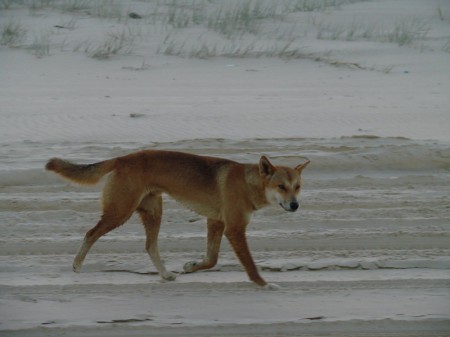
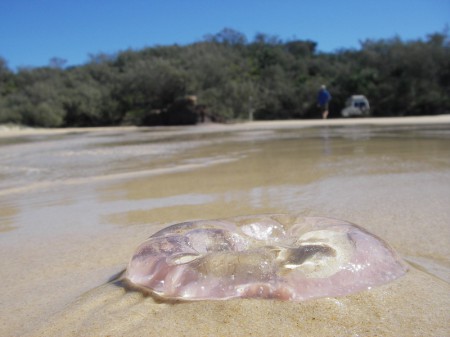
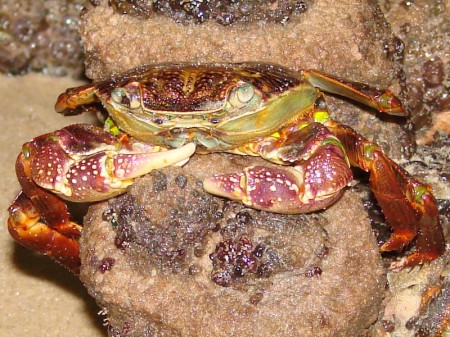 Back on the mainland and in Hervey Bay, we decide to stay a little longer. The place
Back on the mainland and in Hervey Bay, we decide to stay a little longer. The place
is busy with visitors, many of them wanting to see the Humpback Whales Hervey Bay is famous for. The whale watching season has just started and the whales are already here in numbers.
With fond memories of Bundaberg, we just have to do a day trip to the home of a true Australian icon, the legendary Bundy Rum. The distillery runs tours and we enjoy our visit a lot – not just because of the drink at the end of the guided tour. Pretty simple actually to make rum out of molasses, a byproduct of the sugar milling process, but surprisingly delicious. And, according to the manufacturer, enjoyed in moderate quantities, it’s good for your health as well. Not so sure about that!
Every night hundreds and hundreds of flying foxes leave their roosting site and for
several minutes the sky over parts of Hervey Bay is full of the noisy mammals. People watch them with mixed feelings these days, because many of the bats carry the potentially deadly Hendra virus. In Queensland several deaths have been recorded this year. So far, no direct transfer of the virus from bat to human has been established, with horses needed as a second carrier.